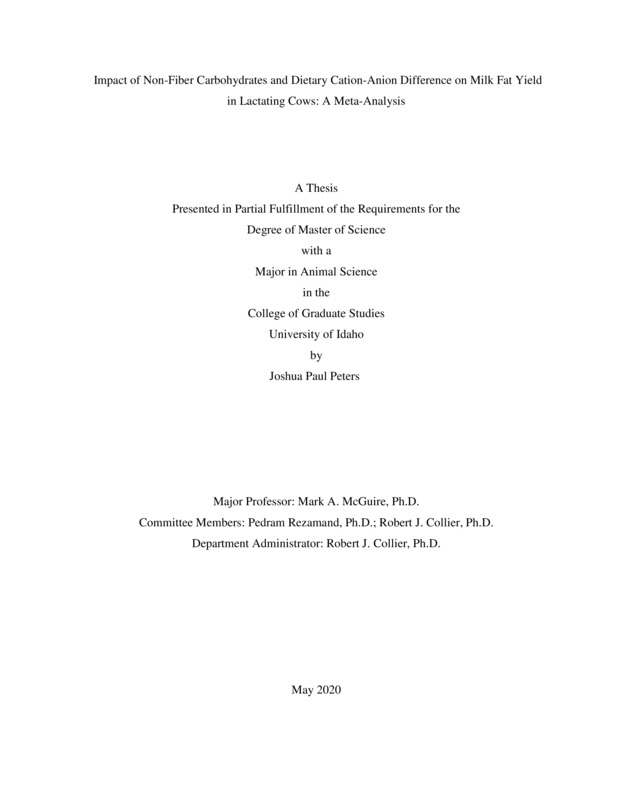Impact of Non-Fiber Carbohydrates and Dietary Cation-Anion Difference on Milk Yield in Lactating Cows: A Meta-Analysis
Peters, Josh. (2020-05). Impact of Non-Fiber Carbohydrates and Dietary Cation-Anion Difference on Milk Yield in Lactating Cows: A Meta-Analysis. Theses and Dissertations Collection, University of Idaho Library Digital Collections. https://www.lib.uidaho.edu/digital/etd/items/peters_idaho_0089n_11830.html
- Title:
- Impact of Non-Fiber Carbohydrates and Dietary Cation-Anion Difference on Milk Yield in Lactating Cows: A Meta-Analysis
- Author:
- Peters, Josh
- ORCID:
- 0000-0002-9847-6837
- Date:
- 2020-05
- Program:
- Animal and Veterinary Science
- Subject Category:
- Animal sciences
- Abstract:
-
Recently, increasing demand for butter has resulted in milk fat accounting for 50% of the value of Class III milk, and increasing milk fat yield (MFY) can positively impact profitability for dairies. Nutritional strategies to accomplish greater MFY can be multifactorial. Increasing non-fiber carbohydrates (NFC) has resulted in a quadratic effect in some studies. Previous meta-analysis evaluating dietary cation-anion difference (DCAD) reported a quadratic or linear relationship to MFY. Some studies fed varying rates of DCAD with different levels of NFC to evaluate lactation performance. To better understand the results of these studies and determine if there were possible interactions between NFC and DCAD, we conducted a meta-analysis. Fifteen studies were identified which reported adequate information for the analysis. Studies included 62 observations, 60 treatment diets, and 362 cows. We hypothesized that increasing DCAD would improve milk fat yield for all levels of NFC and the response to DCAD would be more impactful as NFC in diets became greater. Interactions were tested by binning NFC into Low NFC (mean= 38.6), Medium NFC (mean=42.7), and High NFC (mean=47.1), while DCAD was a continuous variable. A difference in MFY between the model intercept (Low NFC) and Medium NFC was not detected, but there was a reduction (P<0.01) for High NFC (-.242 ± 0.082) compared to the model intercept (Low NFC). Increasing DCAD had a positive linear effect (P<0.05) on MFY for all levels of NFC. The response to DCAD was 0.004 kg/d greater (P<0.05) for High NFC compared to Medium NFC. The positive response to DCAD for all NFC levels and reduction in milk fat yield to High NFC suggests that both DCAD and NFC should be considered when formulating diets to increase milk fat yield.
- Description:
- masters, M.S., Animal and Veterinary Science -- University of Idaho - College of Graduate Studies, 2020-05
- Major Professor:
- McGuire, Mark A
- Committee:
- Rezamand, Pedram; Collier, Robert J
- Defense Date:
- 2020-05
- Identifier:
- Peters_idaho_0089N_11830
- Type:
- Text
- Format Original:
- Format:
- application/pdf
- Rights:
- In Copyright - Educational Use Permitted. For more information, please contact University of Idaho Library Special Collections and Archives Department at libspec@uidaho.edu.
- Standardized Rights:
- http://rightsstatements.org/vocab/InC-EDU/1.0/

